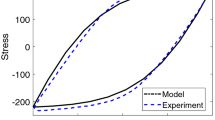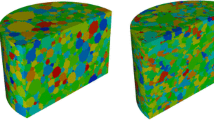Abstract
High-temperature creep tests were conducted on polycrystalline copper of commercial purity in order to investigate the inter-relationship between the extent and the rate of grain boundary sliding (GBS) and the development of internal cavitation. An image processing technique was used to provide quantitative information on the size and shape of the cavities formed over a range of stresses and at temperatures from 673 to 873 K. The results demonstrate that cavity development is inhomogeneous within any specimen, such that there is an increase in the level of cavitation in regions of higher local strain. It is shown by quantitative measurements that the total cavitated area increases at the faster sliding rates, but the number density of cavities decreases at the highest sliding rates because of cavity interlinkage. When interlinkage is taken into account, the results confirm that the overall level of cavitation is related to the occurrence of GBS.
Similar content being viewed by others
References
R.L. Bell and T.G. Langdon: inInterfaces Conference, R.C. Gifkins, ed., Butterworth and Co., Sydney, 1969, pp. 115–37.
H. Gleiter and B. Chalmers:Prog. Mater. Sci., 1972, vol. 16, pp. 179–217.
T.G. Langdon and R.B. Vastava: inMechanical Testing for Deformation Model Development, ASTM STP 765, R.W. Rhode and J.C. Swearengen, eds., ASTM, Philadelphia, PA, 1982, pp. 435–51.
W.R. Cannon:Phil. Mag., 1972, vol. 25, pp. 1489–97. 5. F.R.N. Nabarro: in Report of a Conference on Strength of Solids, The Physical Society, London, 1948, pp. 75-90.
C. Herring:J. Appl. Phys., 1950, vol. 21, pp. 437–45.
R.L. Coble:J. Appl. Phys., 1963, vol. 34, pp. 1679–82.
I.M. Lifshitz:Sov. Phys. JETP, 1963, vol. 17, pp. 909–20.
W.A. Rachinger:J. Inst. Met., 1952-53, vol. 81, pp. 33–41.
T.G. Langdon:Acta Metall. Mater., 1994, vol. 42, pp. 2437–43.
R.C. Gifkins:Acta Metall., 1956, vol. 4, pp. 98–99.
C.W. Chen and E.S. Machlin:Acta Metall., 1956, vol. 4, pp. 655–56.
Y. Ishida and D. McLean:Met. Sci. J., 1967, vol. 1, pp. 171–72.
H.E. Evans:Met. Sci. J., 1969, vol. 3, pp. 33–38.
P.W. Davies and K.R. Williams:Met. Sci. J., 1969, vol. 3, pp. 48–50.
V. Sklenička, I. Saxl, J. Čadek, and P. Ryš:Res. Mechanica, 1980, vol. l,pp. 301–17.
Y. Ma, X. Zhao, and T.G. Langdon: inProc. 4th Int. Conf. on Creep and Fracture of Engineering Materials and Structures, B. Wilshire and R.W. Evans, eds., The Institute of Metals, London, 1990, pp. 199- 208.
S.-A. Shei and T.G. Langdon:J. Mater. Sci., 1978, vol. 13, pp. 1084–92.
I. Saxl, V. Sklenička, and J. Čadek:Z. Metallkd., 1981, vol. 72, pp. 499–503.
A.H. Chokshi and T.G. Langdon:Acta Metall. Mater., 1990, vol. 38, pp. 867–77.
S.V. Raj and T.G. Langdon:Acta Metall., 1989, vol. 37, pp. 843–52.
R.L. Bell and T.G. Langdon:J. Mater. Sci., 1967, vol. 2, pp. 313–23.
R.L. Bell, C. Graeme-Barber, and T.G. Langdon:Trans. AIME, 1967, vol. 239, pp. 1821–24.
T.G. Langdon:Metall. Trans., 1972, vol. 3, pp. 797–801.
S.V. Raj and T.G. Langdon:Acta Metall. Mater., 1991, vol. 39, pp. 1823–32.
A. Ayensu and T.G. Langdon: University of Southern California, Los Angeles, CA, unpublished research, 1994.
T.G. Langdon:Mater. Sci. Eng., 1993, vol. A166, pp. 67–79.
S.V. Raj and T.G. Langdon:Acta Metall. Mater., 1991, vol. 39, pp. 1817–22.
Y. Ishida, A.W. Mullendore, and N.J. Grant:Trans. AIME, 1965, vol. 233, pp. 204–12.
R.L. Bell and C. Graeme-Barber:J. Mater. Sci., 1970, vol. 5, pp. 933- 44.
A.H. Chokshi and T.G. Langdon:Acta Metall., 1987, vol. 35, pp. 1089–1101.
Author information
Authors and Affiliations
Additional information
On leave from the Department of Physics, University of Cape Coast, Cape Coast, Ghana
This article is based on a presentation made at the “High Temperature Fracture Mechanisms in Advanced Materials” sympsosium as a part of the 1994 Fall meeting of TMS, October 2-6, 1994, in Rosemont, Illinois, under the auspices of the ASM/SMD Flow and Fracture Committee.
Rights and permissions
About this article
Cite this article
Ayensu, A., Langdon, T.G. The inter-relationship between grain boundary sliding and cavitation during creep of polycrystalline copper. Metall Mater Trans A 27, 901–907 (1996). https://doi.org/10.1007/BF02649757
Issue Date:
DOI: https://doi.org/10.1007/BF02649757




